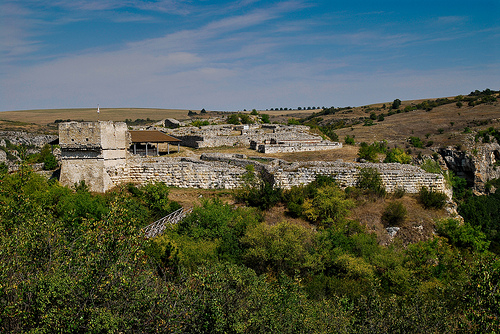
Location: 35 km South of Rousse Map
Constructed: 11th century

Cherven Fortress, also known as the Medieval Town of Cherven (Средновековен град Червен in Bulgarian), is a significant archaeological site representing one of the key strongholds of the Second Bulgarian Empire. Located near the modern village of Cherven in Ruse Province, northeastern Bulgaria, approximately 30-35 kilometers south of the city of Ruse, it sits within the Rusenski Lom Nature Park along the Cherni Lom River. The fortress occupies a high rocky plateau in a bend of the river, providing natural defenses through steep cliffs and ravines, with coordinates around 43°37′14.63″N 26°1′3.51″E. Spanning over 1 square kilometer at its peak, it includes an inner citadel, outer town, and unfortified suburbs, blending Byzantine, Bulgarian, and later Ottoman influences. Recognized as a national archaeological reserve since 1965, it is managed by the Ruse Regional Museum of History and attracts visitors for its well-preserved ruins, scenic views, and insights into medieval urban life. The name "Cherven" means "red" in Bulgarian, possibly referring to the reddish hue of the local rocks or derived from Russian settlers fleeing invasions in the 13th century.
The site's history dates back to Thracian times, with evidence of
habitation from ancient tribes. The fortress proper originated in the
6th century AD as a Byzantine stronghold built under Emperor Justinian
I, part of a defensive network against northern invasions. It was first
mentioned in an 11th-century Old Bulgarian apocryphal chronicle. During
the First Bulgarian Empire (7th-11th centuries), a small settlement
emerged, but Cherven flourished in the Second Bulgarian Empire
(12th-14th centuries), particularly under the Terter dynasty. After
1235, it became the seat of the Bulgarian Orthodox Bishopric of Cherven,
elevating its status as a religious, administrative, and economic
hub—second only to Tsarevets in Veliko Tarnovo. It served as the
residence for Tsar George Terter I and was a vital trade junction on
routes from the Danube to the interior.
The 13th century brought
challenges, including Mongol Golden Horde raids in 1242 and a brief
Byzantine conquest during Tsar Ivailo's reign (1278–1280). By the
mid-14th century, urban expansion peaked, with coin minting indicating
prosperity. In 1388, during the Bulgarian-Ottoman Wars, the Ottomans
captured and destroyed much of it, though it retained some
administrative roles initially before declining. Archaeological
excavations began in 1910–1911 under Vasil Zlatarski, with systematic
digs from 1961 onward. Led by Stoyan Yordanov of the Ruse Museum since
the 1990s, summer excavations continue, uncovering artifacts like coin
hoards, jewelry, pottery, tools, and armaments. Recent developments
include a 2023 3D virtual reconstruction by Tornado Studios, enhancing
educational access, but no major restorations or news for 2024–2025 were
reported as of August 2025.
Cherven's architecture reflects its evolution, with Byzantine
foundations overlaid by Bulgarian medieval expansions. The inner
citadel, on a rocky plateau, features massive fortification walls up to
3 meters thick and 10 meters high, with crenelated parapets and
defensive towers. The eastern wall includes an inner 6th-century layer
and a 13th-century outer addition, while the western section has a
fortified gate from the late 12th century. Key structures include:
Western Battle Tower: A fully preserved 14th-century three-storey
square tower, 12 meters high, with arrowslits; it symbolizes the
fortress and served as a model for Baldwin's Tower in Tsarevets
(reconstructed in 1933).
Feudal Palace: Ruins of a large complex with
thick walls, including a church; it was the administrative center.
Churches and Religious Sites: 16 churches excavated, including a
14th-century one with "warrior saints" murals; they highlight the
bishopric's influence.
Water Supply and Infrastructure: Two
underground passages for water, streets, workshops (e.g., ironworking
and goldsmithing sites with kilns), and residential buildings with
tiered layouts, some featuring clay stoves and internal staircases.
The outer town housed commoners, merchants, and farmers, with
unfortified suburbs nearby. Differences in stonework distinguish
Byzantine (larger scales) from Bulgarian phases.
Cherven was a thriving center of craftsmanship in the 14th century, with industries like iron extraction, metalworking, goldsmithing, and construction. Its bishopric spurred spiritual growth, leading to nearby rock monasteries like those in Ivanovo (UNESCO-listed). Archaeologically, it provides crucial insights into medieval Bulgarian urban development, architecture, and daily life. The site influenced modern reconstructions and even appeared in "Game of Thrones." Cherven Peak in Antarctica is named after it, underscoring its legacy.
As of 2025, Cherven remains in ruins but well-preserved, with ongoing excavations by the Ruse Museum. Declared an archaeological reserve in 1997, it is accessible via a 240-step staircase (easy climb) or paths, with a one-way route for safety. Entry costs about 4 BGN (2 EUR) for adults, 1 BGN for students, and 3 BGN for groups; guided tours in Bulgarian are available, with English info limited. Visitors praise the breathtaking views, solitude, and historical atmosphere (4.5/5 on Tripadvisor), but note uneven terrain—wear sturdy shoes and watch for wildlife like snakes. Best visited by car from Ruse (via Ivanovo); combine with Ivanovo Rock Churches, Basarbovo Monastery, or Orlova Chuka Cave. The 3D VR experience offers virtual tours for remote access.